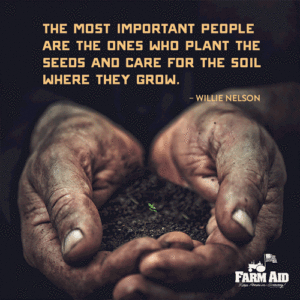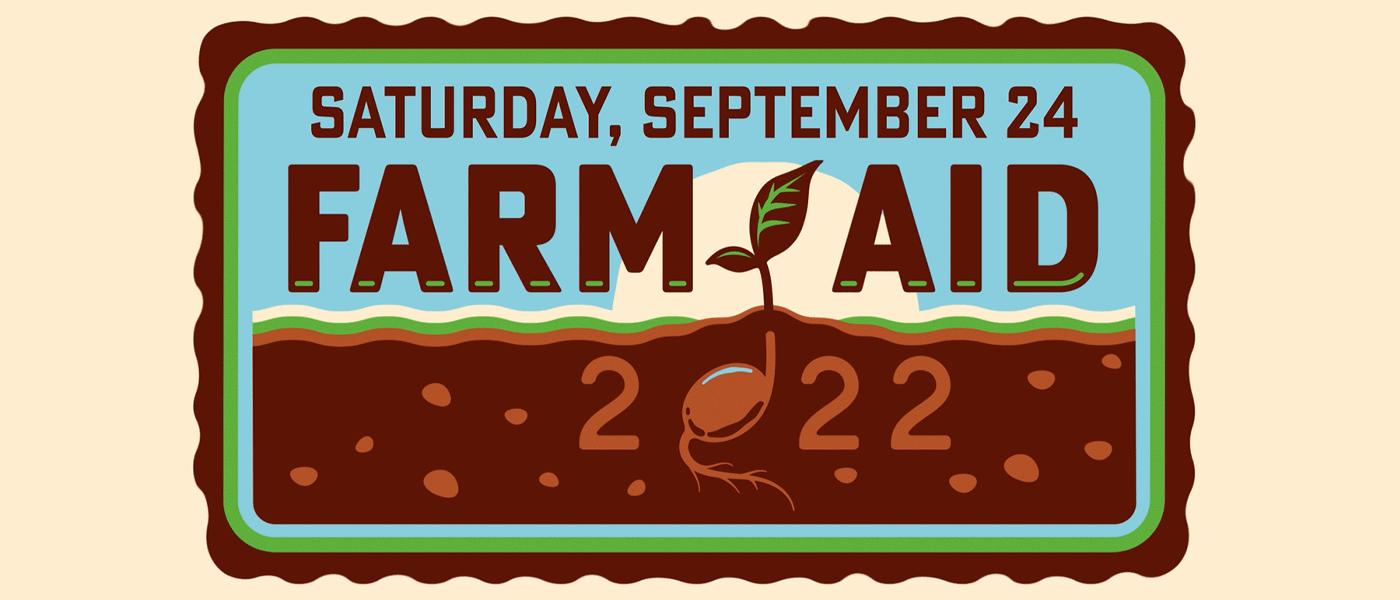When festival season approaches and the details have been set, we start getting our creative juices flowing and our minds rolling on an event logo that represents that year’s Farm Aid festival. It’s no easy task to create something simple and meaningful. I chatted with Steve Snyder, Farm Aid’s Development and Brand director who heads up this process, to learn the ins and outs of how the logo gets designed and the meaning behind the one for Farm Aid 2022.
Jessica: Can you talk about the basic process of designing an event logo?
Steve: Sure. Typically, we provide what is called a creative brief to a handful of designers to start. This gives them a framework of what we’re looking for in terms of festival direction and the themes that we’re trying to convey, as well as characteristics of places where the festival will be. They go off and create some rough drafts that they present to us and we review them and pick the ones that we feel have the most potential to develop further. The next round is refining; and after a lot of back and forth, we eventually arrive at a chosen direction that represents our festival and the themes for that particular year.
Jessica: What are the things we’re trying to represent this year?
Steve: This year we’re focused on climate change, and specifically the importance of soil health. We want to represent the role that family farmers play in taking care of the land as stewards of our soil and water. Also, the logo makes a nod to the region of the country we’re in. The soil health part is represented in the musical note (it also represents the music element of our festival), as it’s a seedling taking root in the soil and beginning to flourish.
Jessica: I know we also strive for our logos to have a celebratory nature, right?
Steve: Yes! You’re right. The festival is really a celebration of family farmers and all that they do to nurture and sustain, not only us, but our communities more broadly. And the musical note is really a nod to how music brings us together. Also, the colors being vibrant bring the sense of sun and life.
Jessica: This logo doesn’t read doom and gloom even though climate change may feel like that.
Steve: Totally. Although climate change is threatening for agriculture and our daily lives, we didn’t want the logo to feel heavy. So, the vibrant color palette and the music note and the seedling offer a sense of hope.
Jessica: What about the colors that you chose?
Steve: The reddish brown of the soil was very intentional. It could’ve felt heavy, but there’s a nice harvest element to it, and then we had the designer integrate brighter colors to make it feel happy and vibrant. The bright green represents hope and growth in agriculture.
Speaking of details, the lines in that horizontal ripple across the logo represent crops. Overall, we wanted to keep it simple so that it immediately conveys the sense of soil health.
I should note that there are number of different variations of a festival logo. That way we can use it across electronic, broadcast and for two-dimensional printed design.
Jessica: Will people be able to find this logo on t-shirts and other merchandise?
Steve: We sell a variety of different designs on our merch items. Each year’s festival logo always appears on at least one, as well as hats and sometimes stickers and other items.
Jessica: Lastly, can you tell us who the designer is this year?
Steve: His Name is Matthew Flemming, from Washington State. We’ve worked with him over several years. He’s great at logo design and we like working with him. There’s a simplicity that’s required to convey several different attributes of something succinctly in order for it to be successful, and some designers specialize in this area; Matt is one of them.

Jessica: Farmers and ranchers are often the canaries in the coal mine when it comes to climate change. They feel, and reel from, the consequences of increased floods, droughts, wildfires and hurricanes before many other industries. But they also have a unique vantage point since their work is in sync with the natural environment, putting them in a good position to be part of the climate solution.
Like Steve mentioned above, one important part of this is their ability to help nurture the soil by planting specific crops and by using rotation techniques to pull carbon out of the air and store it in the ground. With cover crops and improved grazing management techniques, they can further help to sink carbon deep into the ground. What’s great about all of these regenerative practices is they help farmers adapt to natural disasters by increasing how much water the soil can hold and reducing the amount of erosion taking place on the farm (keeping that lovely, nutrient-rich soil in place).
Farmer Letter on Climate Change in Agriculture The Agriculture Resilience Act Offers Farmers Climate Change Solutions Family Farmers Need America to Lead on Climate Change Family Farmers on the Frontlines of a Changing Climate



